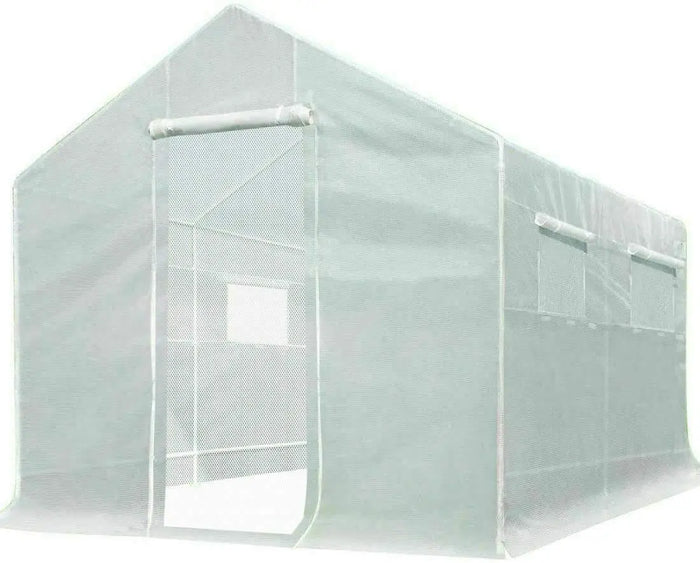If you are making plans to grow vegetables this year, include peppers in your plans. Pepper plants are the most rewarding vegetables you can grow. While you should start planting your peppers in late winter or early spring, it's not too late!

(colorful peppers)
In this blog, we provide you with tips for growing peppers in the spring. Making pepper growing easier!
What climate do pepper plants need?
Pepper plants thrive in warm and sunny locations. The ideal temperature is 70°F to 80°F during the day and 60°F to 70°F during the day. from seedlings to fruit, peppers need strong light to grow best. Peppers need 6 to 8 hours of sunlight per day.
What is the optimum soil pH for peppers?
The pH of the soil has a great impact on the flavor of peppers. The optimal pH for peppers is 6.0 to 7.0. Peppers grown in this range of soil can absorb nutrients such as phosphorus and magnesium.

(pH scale)
It is important to note that there are many species of peppers and there is a wide variation in the tolerance of these plants. Most peppers could adapt to low-pH soils.
Tips for growing peppers in different environments
Peppers are an easy vegetable to grow and can be grown in many environments, such as balconies, backyards, and greenhouses. As a result, peppers are one of the favorite vegetables for many gardening enthusiasts.
You need to know multiple growing tips if you want to grow peppers in different environments.
Growing peppers in the greenhouse
Peppers are a heat-loving vegetable, and if the temperature in your area is cold all year round, growing them can be a difficult task. But if you have a greenhouse, this will become easier.

(greenhouse red peppers)
Growing peppers requires patience and time. It takes about 1 to 4 weeks for the seeds to germinate, depending on the soil and the conditions inside the greenhouse.
- Moisture.
Pepper plants need plenty of water to grow, but one mistake many gardeners may make is to over-water. Moist soil conditions are not conducive to pepper growth and can spread fungi and pathogens. You should always observe the soil conditions and check the moisture level by touching the soil with your hands. If the soil feels dry, it should be watered promptly. If the soil is moist, please wait.
- Light.
Pepper plants need plenty of light to thrive. To ensure the light, you'd better set up plant grow lights inside the greenhouse. For areas with lots of light year-round, natural light can provide plenty of light for plants. However, if limited by natural conditions, artificial light intervention is necessary.
You'd better choose the right size to grow light according to the pepper planting area.
- Fertilization.
Pepper plants require a variety of nutrients for their growth process, but if too much fertilizer is applied, it can also hurt the plants.
Too many nutrients can cause peppers to produce many green leaves but few fruits. A well-balanced water-soluble fertilizer is better for the growth process of peppers. If the plant blooms, you can switch to a high-potassium fertilizer to increase production.
When using fertilizers, you should use the amount and dosage. If you find that you are using too much fertilizer, you can water more to rinse off the excess nutrients.
- Pests and diseases.
One important reason gardeners choose to grow peppers in greenhouses is to try to avoid pests and diseases that can harm them. Aphids are a pest that can harm plants, and a greenhouse will keep them out of the house.
As the pepper fruit reaches the ripening stage, you should watch the plant for bacterial spots. Once found, you should use a fungicide to control it and prevent the situation from getting worse.
Quictent greenhouse recommendation
This Quictent 8'x10' backyard greenhouse is a good size for growing a variety of plants such as peppers.
- Frame: White powder-coated steel
- Total weight::44 lb
- Benefits: Good Ventilation, Ease of Setup,Sturdy Frame
This white greenhouse is aesthetically pleasing and constructed of heavy-duty powder-coated steel poles for durability and cost-effectiveness. There are multiple vents on both sides of the greenhouse to enhance ventilation inside the greenhouse.
Whether you are transplanting or growing in a greenhouse, this home greenhouse is the ideal greenhouse choice for your pepper cultivation.
Growing peppers in the raised garden bed
You probably don't want to keep peppers growing in a greenhouse. When the peppers reach a certain stage of growth, you'll transplant them outdoors into a raised garden bed.
Before transplanting, you will need to do the following preparations.
Prepare the compost. You should prepare the soil about a month before transplanting. To enrich the soil with nutrients, it is recommended that you add compost.
 (peppers in flower bed)
(peppers in flower bed)
Decaying leaves, livestock manure, and other organic matter can be made into compost. You should add 1-3 inches of compost to the surface of the raised flower bed.
Then use a tool to gently loosen the soil and allow the compost to enter the soil.
Allow the plants to acclimate to the weather. When the weather starts to warm up, you can consider gradually moving your peppers outside to acclimate to the weather conditions. Allow your plants to acclimate outdoors for 30 minutes each day, then bring them back into the greenhouse or indoors.
This adjustment should continue for about a week, and when the outdoor temperature is consistently above 55°F, you can transplant your peppers outdoors.
Notes on growing peppers in raised garden beds
- Use tools.
Wooden stakes and tomato cages are ideal support tools. They will help support the pepper fruit and protect the peppers from the wind.
- Water properly.
Pepper plants need plenty of water to thrive. In the summer, peppers need about 1.5 inches of water per week. As temperatures gradually rise and humidity decreases, peppers will need more water.
Recommended watering methods include hose watering, drip irrigation, and hand watering.
- Plant other plants such as flowers.
Pests may nibble on your pepper plants. To prevent pests from harming your peppers without using pesticides, you can plant flowers or other plants to attract beneficial insects. Basil, marigolds, garlic, and onions are recommended plants.
Quictent garden bed recommendation
49''x37''x36'' Galvanized Garden Bed with Cover. This product combines the use of a greenhouse with a garden bed. It will protect your pepper plants from the natural elements. This two-in-one raised garden bed is suitable for a variety of scenarios, whether it's a patio or a garden.
 (49''x37''x36'' Galvanized Garden Bed with Cover)
(49''x37''x36'' Galvanized Garden Bed with Cover)
Two huge zippered windows allow you to observe your plants, let in more sunlight, and ensure ventilation.
Growing peppers in the pot
Even if you don't have a greenhouse or garden bed, you can still grow peppers in pots. The following suggestions can help you achieve success.
- Choose the right pot.
It is important to choose the right size pot. Pots that are too small may not be able to support the pepper fruit. When considering pot size, you should also look at pepper varieties. Some varieties of peppers can grow in small pots. However, it is best to choose a container that is at least 1 foot in diameter and at least 10 inches deep.
- Make sure the pot has drainage holes.
Pepper plants will not grow healthily in pots that are soaked with water. If needed, you should drill additional drainage holes in the bottom of the pot.
- Purchase soil for potted plants.
The soil environment inside pots is different from that in garden beds and greenhouses. In pots, the soil is more likely to dry out.
 (growing peppers in pot)
(growing peppers in pot)
You should buy special soil formulated for the container environment. This soil needs to be fast draining, absorb water evenly, and not easily compacted.
Conclusion
Spring is the perfect season for your pepper plants! Greenhouses, garden beds and containers are all ideal environments for pepper plants to grow.Hope your peppers thrive and have a good harvest!








